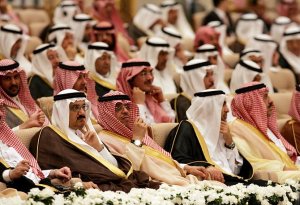
However, the Saudis have forgotten that they themselves provoked these processes in the Middle East, which are now interpreted widely as the creation of a “Shiite arch” or a “Shiite crescent”. Beginning with Egypt and Libya, where Saudi Arabia, Qatar and a number of other countries within the Gulf Cooperative Council have actively supported Islamist opposition and acts of extremism, which led to replacement of moderate regimes, the Saudis then decided to get hold of Syria, but that was where this progress halted. Riyadh failed to take into account that Damascus gained active support from Moscow, Tehran, Baghdad, the Hezbollah from Lebanon, and the majority of Syrian people who refuse to live by the Wahhabite interpretation of the sharia, the Moslem sacred law. Moreover, Riyadh dared to undertake open interference into Iraq’s internal affairs, despite the fact that Baghdad is now the seat of the legal government of the Shiite majority, and began to provoke Tehran with appeals to the USA and Israel for strikes against the Islamic Republic of Iran’s nuclear facilities. As a result, Syria, Iraq and Iran had to defend themselves against such brazen interference by uniting their military and political resources. This does not mean creating a kind of a formal alliance of the three countries, but rather coordinating their efforts when facing the aggressive stance of the Sunnite axis shaped by Saudi Arabia. It is no secret that given the open interference of Saudi Arabia into the armed conflict with the Syrian Arab Republic, including funding the rebels and supplying them with weapons, Iran had to send its military personnel as instructors for the Syrian army, while members of the Corps of Islamic Revolution Guards ensure the security of President Bashar Assad. Iraq sent to Syria volunteers from the paramilitary Mahdi’s Army force headed by Shiite leader Mustapha Sadr, and the Hezbollah has repeatedly sent its fighters into Syrian territory to help the local government repel attacks from the opposition and their mercenaries. Besides this, Tehran regularly provides military and technological aid to Damascus, and this fits well with the standards of international law, to the contrary of what the Western and Arabic countries have done, when choosing to supply weapons to the illegal armed forces of Saudi extremist organizations.
Following this shortsighted policy, the Saudis may face a harder reaction in the form of a military alliance between the Islamic Republic of Iran, Iraq, Syria and the Hezbollah. Meanwhile, such prospects have already started to worry the USA, which decided to send its drones to Iraq to strike terrorist camps of the extremist organization Jabghat an-Nusra that invaded the west of Iraq from Syria. This is a sign to the Saudi Kingdom that it must not cross a certain “red line”. Obviously, such issues will be on the agenda of negotiations for U.S. President Barack Obama, who has embarked on a visit to this region. However, even more moderate parties in Riyadh have also reacted to the powerful wave of criticism against the Saudi policies of supporting extra-radical Islamists. On January 30, King Abdullah approved an order to punish any kingdom citizens engaged in mercenary activities abroad – with 30 years of imprisonment, and the supreme mufti of the Kingdom of Saudi Arabia condemned the radical Salafist movement.
Those in Riyadh must realize that continuing to play with fire in their foreign policy may backfire on Saudi Arabia, which is far from being in the best condition now. King Abdullah is already 89 years old and he is ill. The crown prince is a little younger, but he is also ill. The next generation, grandchildren of the king who founded the Saudi state are also elderly people. Many of them are almost 70 years old or already in their sixties, and competing against each other for power. Particular efforts are taken by Prince Bandar, who has a serious disadvantage – he is the son of a concubine, not a king’s wife. The Shiite population of the kingdom, which is concentrated mostly in the eastern province, accounting for 85% of the oil output, is becoming more active it its protests, being dissatisfied with religious discrimination. In the south, in Najran Province, populated by the Shiite sect of Ismaelites, dissatisfied voices are getting stronger because of the Wahhabite standards of life imposed on them. In Al-Asir, bordering on Yemen, tribes of Yemen origin are also raising their heads, with their numbers approaching the figure of 3 million people. In Hijaz, the Western province of the kingdom, dissatisfaction of local business people is quite noticeable, as they are demanding equal business opportunities with entrepreneurs of royal origin.
Therefore, the Persian Gulf Region is about to face interesting – and troubled – times. The most important thing at stake will be the destiny of Saudi Arabia. Will it be able to survive as a unified state when the generations of rulers change, or will it break into several parts? We should recall that the kingdom was created artificially some 80 years ago on the ruins of the Ottoman Empire with the most active participation of the British Empire, and now, powerful players as Iraq and Iran are taking to the Eastern stage.
Alexander Orlov, political analyst, Orientalist expert, exclusively for the online magazine New Eastern Outlook.
